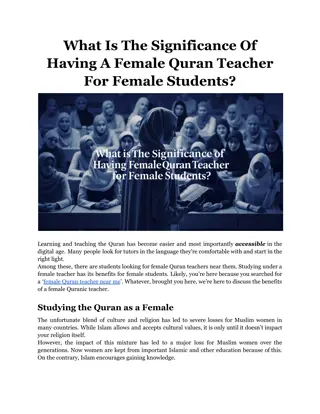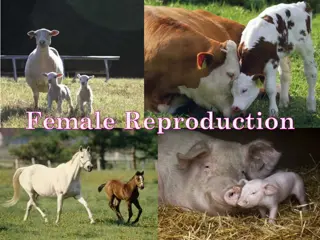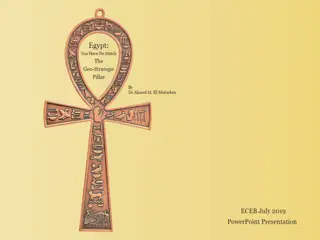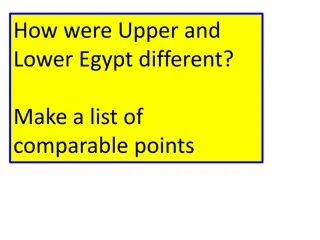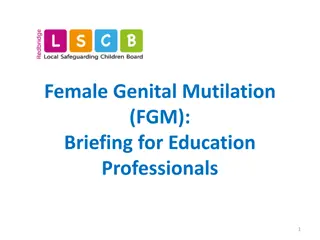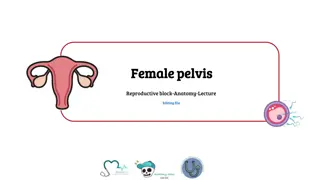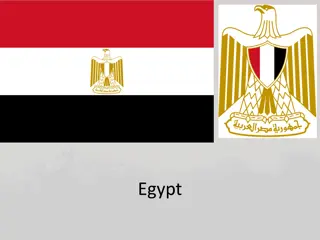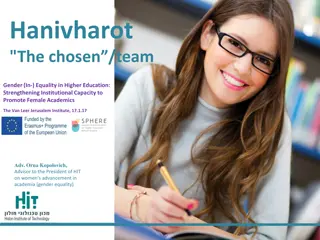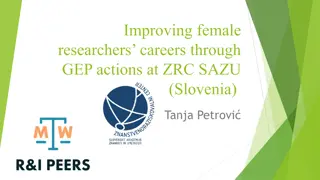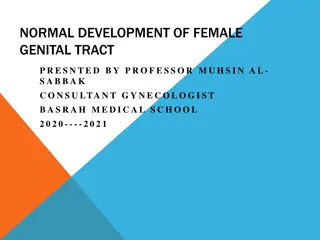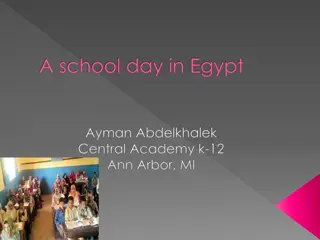Challenges & Opportunities for Female Education in Egypt
Egypt's female education landscape faces various challenges despite opportunities for empowerment. Issues such as overcrowded classrooms, poor teaching quality, and a disconnect between university skills and market needs hinder progress. Despite a literacy rate of 74%, there is room for improvement in promoting education as a tool for women's empowerment in Egypt.
Download Presentation

Please find below an Image/Link to download the presentation.
The content on the website is provided AS IS for your information and personal use only. It may not be sold, licensed, or shared on other websites without obtaining consent from the author.If you encounter any issues during the download, it is possible that the publisher has removed the file from their server.
You are allowed to download the files provided on this website for personal or commercial use, subject to the condition that they are used lawfully. All files are the property of their respective owners.
The content on the website is provided AS IS for your information and personal use only. It may not be sold, licensed, or shared on other websites without obtaining consent from the author.
E N D
Presentation Transcript
WOMEN EMPOWERMENT THROUGH EDUCATION IN EGYPT: CHALLENGES & OPPORTUNITIES Egypt s Team Anissa Hassouna Marian Malak Noha Bakr 1
PRESENTATION OVERVIEW I. Back Ground Information about Egypt II. Women Conditions in Egypt in General III. Opportunities to Empower Female Education in Egypt IV. Challenges to Empower Female Education in Egypt V. Recommendations 2
I. BACK GROUND INFORMATION ABOUT EGYPT Population : 94.6 million, with an annual growth rate of 2.5 % -birth rate: 23.35/1000; -infantmortality rate: 22.41/1000; -life expectancy: 73.45 About half of Egyptians reside in urban areas, particularly the capital and largest metropolis Cairo (estimated population 18.8 million) and Alexandria (estimated population 4.8 million) live in the fertile areas of the Nile Valley and along the Suez Canal, an area comprising just 6 to 7% of the country. 3
I. BACK GROUND INFORMATION ABOUT EGYPT The World Bank classifies Egypt as; a lower middle- income country. Egypt s economy has relatively large tourism, agricultural and services sectors; derives substantial revenues from the Suez Canal; receives considerable remittances from overseas workers; and garners some additional income from the sale of hydrocarbons Egypt s poverty rate (defined as those living on less than $US2 per day) had risen to 27.8 % in 2015 compared to 25.2 per cent in 2010/11 4
I. BACK GROUND INFORMATION ABOUT EGYPT Education in Egypt: 95%vof children attended primary school in 2013/4, Participation rates in secondary school dropped to 64%. There was no significant variance between the rates of participation for girls and boys. The country's literacy rate (adults 15 years+) is at only 74% Egypt s Public education system has faced criticism for overcrowding in classrooms, poor teaching quality, over- centralised control, a focus on rote learning for examinations, entrenchment of social inequalities, and inadequate university access, funding and research capacity. Quality in the private education sector is better. Vocational education available but not highly qualified for market needs 5
I. BACK GROUND INFORMATION ABOUT EGYPT Education in Egypt: There is a considerable disconnect between the needs of the Egyptian economy and the skills taught in Egypt s universities. Vocational education & training has limited availability, and a social stigma attaches to vocational graduates Unemployment 13-10% Challenges in calculation due to economy informal sector 6
II. WOMEN CONDITIONS IN EGYPT IN GENERAL Article 11 of the Constitution; commits the state to achieving equality between women and men, commits the state to ensuring appropriate representation of women in national bodies. There are considerable legal protections for women in many areas, including on personal safety, participation in the workforce, and mandatory schooling for girls. 7
II. WOMEN CONDITIONS IN EGYPT IN GENERAL Law 46/2014 stipulates the presence of 56 women on party lists as well as 14 women appointed directly by the President. This contributed to an improvement in female political representation in the current Parliament, which has 89 female MPs making up 15% of the Parliament (compared with two per cent during the last Parliament in 2012). 8 Ministers in Recent Cabinet are women (First time ever) President Sisi s national security advisor is a woman. President Sisi appointed Egypt s first female Governor in February 2017. 8
II. WOMEN CONDITIONS IN EGYPT IN GENERAL Why is reducing the gender enrollment gap at all levels of education important to Egypt Education is actually a key means of empowering women and is in itself a human right. Educated girls lead better lives. Education is especially central to women's empowerment in so far as it enables women to become more productive both inside and outside the household. 9
II. WOMEN CONDITIONS IN EGYPT IN GENERAL Why is reducing the gender enrollment gap at all levels of education important to Egypt To reduce gender gaps across a wide range of sectors and activities To reduce constraints to women s economic participation; To enhance addressing sexual harassment and gender-based violence; 10
II. WOMEN CONDITIONS IN EGYPT IN GENERAL Why is reducing the gender enrollment gap at all levels of education important to Egypt Empowering women and integrating them as active participants in the economy is essential to promoting economic growth in Egypt. According to the IMF, raising the female labor force participation rate to the male level, coupled with access to employment opportunities, would increase GDP by approximately 34 percent. 11
III. OPPORTUNITIES TO EMPOWER FEMALE EDUCATION IN EGYPT Women participate in all areas of Egyptian society, including government, business and civil society. 6 Ministers/89 Parliamentarians/National Security Councilor /Police Women Legislative Frame work is there Constitution & Laws Political will & Support are there President Speeches/ Meetings 12
III. OPPORTUNITIES TO EMPOWER FEMALE EDUCATION IN EGYPT Partners in Development Support US AID (Stem Schools, Seeds Program, Higher School Initiative) UN Women Targeting young women and girls in five communities in the governorates of Greater Cairo, Minia, Luxor, Aswan and the Red Sea, UN Women aims to reduce the gender gap in education, both in formal and informal schools, to: Strengthen the quality of formal educational institutions and community mechanisms to promote education of young women and girls 13
III. OPPORTUNITIES TO EMPOWER FEMALE EDUCATION IN EGYPT Partners in Development Support US AID (Stem Schools, Seeds Program, Higher School Initiative) UN Women Targeting young women and girls in five communities in the governorates of Greater Cairo, Minia, Luxor, Aswan and the Red Sea, UN Women aims to reduce the gender gap in education, both in formal and informal schools, to: Strengthen the quality of formal educational institutions and community mechanisms to promote education of young women and girls 14
III. OPPORTUNITIES TO EMPOWER FEMALE EDUCATION IN EGYPT One Class School for dropped schooling girls Conditionality of Poverty Cash Transfer programs Vibrant Civil society activities in this domain 15
IV. CHALLENGES TO EMPOWER FEMALE EDUCATION IN EGYPT The quality of formal public educational institutions Male & Female Challenge Education is not compatible with market needs The quality of education is not less important than getting education. New Strategy being approached to develop education focusing on Curriculums Teacher s capacity enhancement School environment Quality verses Quantity Technological Oriented 16
IV. CHALLENGES TO EMPOWER FEMALE EDUCATION IN EGYPT Societal, cultural and miss understanding of religion After all they will end up married. OR Literacy requires a holistic approach; reading and writing is not sufficient, it must incorporate fundamental areas such as health, nutrition, politics, child-rearing and religion." & "We must overcome such ignorance; education is the key to development, we cannot guarantee democracy if women are not included in the transformation. 17
IV. CHALLENGES TO EMPOWER FEMALE EDUCATION IN EGYPT Societal, cultural and miss understanding of religion barriers continue to place considerable limits on women rights & participation. Female genital mutilation (FGM) has been illegal in Egypt since 2008 (Law 126/2008, amending the provisions of the Child Law). However, prosecutions under the Law are rare, and have generally been limited to cases where girls die after undergoing the procedure. FGM is a strongly held tradition in Egypt. It is widely practiced throughout the country among both Muslim and Christian communities, and strong social and patriarchal pressures exist on young women and girls to undergo the procedure in order to get married. 18
IV. CHALLENGES TO EMPOWER FEMALE EDUCATION IN EGYPT The implementation of constitutional protections can be frequently dependent on the individual discretion of police, prosecutors or judges as some in rural areas, allow their religious or cultural view of women to influence their findings. 19
IV. CHALLENGES TO EMPOWER FEMALE EDUCATION IN EGYPT Poverty is a fundamental issue facing female , education With limited resources, & inability to afford education costs, female education is thus viewed as a matter of secondary importance to that of educating male In rural areas young female can be pushed for labor (Child Labor) in farms or small informally registered factories to sustain their brothers education 20
V. RECOMMENDATIONS Addressing these social obstacles requires: First: campaigns to raise awareness of the importance of female education. Second: Such campaigns are not expected to have a significant impact in the short run unless accompanied by legal reforms. There is a need to introduce more deterrent penalties against parents not sending their daughters to primary and preparatory schools and also against early marriage. 21
V. RECOMMENDATIONS Addressing these poverty obstacles requires: In the long run, adopting effective poverty alleviation policies is essential. In the short and medium run, there is a need for policy interventions to: First: provide incentives for poor families to encourage them to send their children, especially female children to school. Two interventions are highly recommended: a) Increasing the number of beneficiaries of social security pensions and increasing the pension paid to support pre-university students from beneficiary families and adding university students as beneficiaries b) Expanding the using of conditional cash transfers programs which have proved to be very successful in many developing countries 22
V. RECOMMENDATIONS Addressing the Female School Dropout Factors leading to female school dropout are classified into four groups 1) School shortages (no school available or too far) The unavailability of schools in higher levels of education is a problem in rural areas. Thus, there is a need for more investment in building these schools in rural areas. 2) Economic obstacles: Economic obstacles are more important as obstacles to continuing studying than to school enrollment. Costs of education rise, the higher the education level is. 3) Social Factors: Families accepting sending their girls to schools are less likely to make them drop out of school because of social factors. 4) School Failure: One of the main factors that lead to school failure is low quality education. Of the young females surveyed, 100% of those who dropped out of school were previously enrolled in regular public primary school 23
RECOMMENDATIONS Redistribution of Investment among Different Types of Vocational and University Education There is a need to redistribute investments in vocational and university education, considering labor market demand for graduates by field of study. For instance, the female unemployment rate is very low (1.4%) among those graduated from vocational nursing schools while it increases to more than half of those who graduated from industrial-vocational secondary schools, and to more than 2/5 of those who graduated from agricultural-vocational secondary schools. 24
V. RECOMMENDATIONS Civil Society Role: NGOs though vibrant in this sector but needs further cooperation & coordination with government institutions NGOs should play a more effective role in providing poor families with school supplies to lower financial burden of education. 25
V. RECOMMENDATIONS Partners in Development Role UNESCO UNICEF EU programs South/ South technical Capacity sharing (we don t need to reinvent the wheel) 26
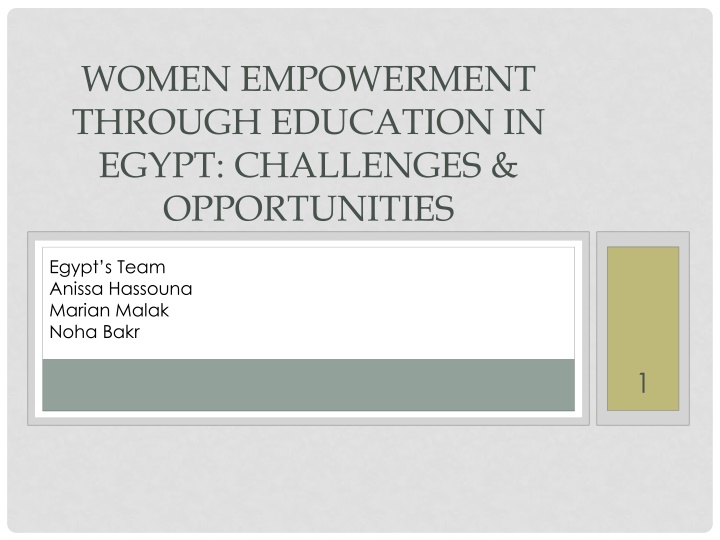

![[PDF⚡READ❤ONLINE] Tutankhamun's Trumpet: Ancient Egypt in 100 Objects from the](/thumb/20549/pdf-read-online-tutankhamun-s-trumpet-ancient-egypt-in-100-objects-from-the.jpg)
